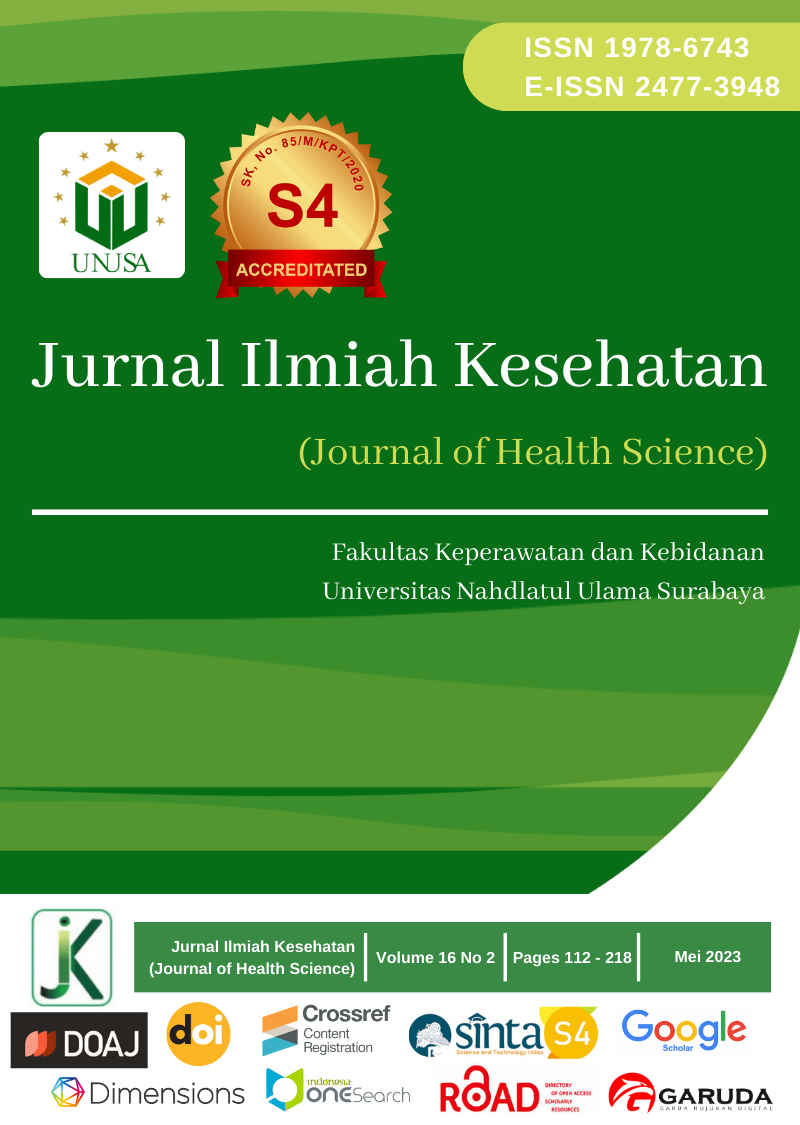Effective Simulation Methods Improve Student Skills in Performing Basic Life Support
Main Article Content
Abstract
Almost ten thousand people are affected by cardiac arrest, and the prevalence tends to increase every year in Indonesia. Nursing students need to have skills in performing basic life support (BLS) to increase the survival rate of patients with cardiac arrest inside or outside the hospital. An effective method for facilitating students in gaining such skills is educational simulation. This study aims to identify the effectiveness of the simulation method in improving students' skills in providing BLS. This is a quantitative quasi-experiment with a pre-posttest design. The sample is all fourth-year students in Nursing at Poltekkes Kemenkes Mataram who have had emergency classes in the previous semester. Data were collected using observation sheets and analyzed using the Wilcoxon Signed Rank Test to identify students' skills before and after they were given educational simulations. Before the educational video method was implemented, most respondents had insufficient skills in carrying out BLS, with 11 people (55%) falling into this category. Only two respondents (10%) demonstrated good skills in conducting BLS. After the simulation, all respondents acquired the skills to perform BLS in the "good" category, with 32 people (82%) exhibiting these skills. There were no respondents who had sufficient or poor BLS skills. Educational simulation significantly influenced students' skills in performing BLS (p=0.000). It can be concluded that the simulation method was effective in improving the students' skills in performing BLS. Educational simulation of BLS can be applied as an alternative method in the learning process.
Downloads
Article Details
Copyright (c) 2023 Hadi Kusuma Atmaja, Mira Utami Ningsih, Erien Luthfia, Muhammad Hasbi, Satriya Pranata

This work is licensed under a Creative Commons Attribution-ShareAlike 4.0 International License.
References
Ahayalimudin, N. A., & Osman, N. N. S. (2016). Disaster Management: Emergency Nursing And Medical Personnel’s Knowledge, Attitude And Practices Of The East Coast Region Hospitals Of Malaysia. Australasian Emergency Nursing Journal, 19(4), 203–209. https://doi.org/10.1016/j.aenj.2016.08.001 DOI: https://doi.org/10.1016/j.aenj.2016.08.001
Arbon, P., Ranse, J., Cusack, L., Considine, J., Shaban, R. Z., Woodman, R. J., Bahnisch, L., Kako, M., Hammad, K., & Mitchell, B. (2013). Australasian Emergency Nurses’ Willingness To Attend Work In A Disaster: A Survey. Australasian Emergency Nursing Journal, 16(2), 52–57. https://doi.org/10.1016/j.aenj.2013.05.003 DOI: https://doi.org/10.1016/j.aenj.2013.05.003
Atmaja, H. K., Pranata, S., Augustin, K., & Luthfia, E. (2022). Accessibility of e-EWSS versus Manual EWSS for Detecting the Emergency Condition among Patients with Coronavirus Disease 2019: A Survey Research on Register Nurse in Indonesia. Open Access Macedonian Journal of Medical Sciences, 10(G), 286–289. https://doi.org/10.3889/oamjms.2022.8678 DOI: https://doi.org/10.3889/oamjms.2022.8678
Brewer, C. A., Hutton, A., Hammad, K. S., & Geale, S. K. (2020). A Feasibility Study On Disaster Preparedness In Regional And Rural Emergency Departments In New South Wales: Nurses Self- Assessment Of Knowledge, Skills And Preparation For Disaster Management. Australasian Emergency Care, 23(1), 29–36. https://doi.org/https://doi.org/10.1016/j.auec.2019.12.005 DOI: https://doi.org/10.1016/j.auec.2019.12.005
Hammad, K. S., Arbon, P., Gebbie, K., & Hutton, A. (2012). Nursing In The Emergency Department (Ed) During A Disaster: A Review Of The Current Literature. Australasian Emergency Nursing Journal, 15(4), 235–244. https://doi.org/10.1016/j.aenj.2012.10.005 DOI: https://doi.org/10.1016/j.aenj.2012.10.005
Kemenkes. (2018). Laporan Nasional RISKESDAS. https://www.litbang.kemkes.go.id/laporan-riset- kesehatan-dasar-riskesdas/
Keto, J., Ventola, H., Jokelainen, J., Linden, K., Keinänen-Kiukaanniemi, S., Timonen, M., Ylisaukko- oja, T., & Auvinen, J. (2016). Cardiovascular disease risk factors in relation to smoking behaviour and history: a population-based cohort study. Open Heart, 3(2), e000358. https://doi.org/10.1136/openhrt-2015-000358 DOI: https://doi.org/10.1136/openhrt-2015-000358
Liao, C. (2021). Emergency stress management among nurses : A lesson from the COVID-19 outbreak in China – a cross-sectional study. May 2020, 433–442. https://doi.org/10.1111/jocn.15553 DOI: https://doi.org/10.1111/jocn.15553
Mulianda, D., Rahmanti, A., Margiyati, M., Sari, N. W., Haksara, E., & Pranata, S. (2022). Behavioral Activation, Mindfulness Exercises, and Loving-Kindness Meditation Exercises as Effective Therapies to Reduce Stress among Nursing Students’ during COVID-19 Pandemic. Open Access Macedonian Journal of Medical Sciences, 10(G), 228–232. https://doi.org/10.3889/oamjms.2022.8695 DOI: https://doi.org/10.3889/oamjms.2022.8695
Pranata, S., Widodo, S., Vranada, A., & Mariyam, M. (2021). How to Prepare a School Based Disaster Preparedness in Indonesia. 33(ICoSIHSN 2020), 528–533. DOI: https://doi.org/10.2991/ahsr.k.210115.103
Priester, L. De. (2016). An approach to the profile of disaster risk of Indonesia. Emergency and Disaster Reports, 3(2), 66.
Purwadi, H., Breaden, K., McCloud, C., & Pranata, S. (2021). The SALT and START Triage Systems for Classifying Patient Acuity Level: A Systematic Review. Nurse Media Journal of Nursing, 11(3), 413–427. https://doi.org/10.14710/nmjn.v11i3.37008 DOI: https://doi.org/10.14710/nmjn.v11i3.37008
Sari, A. L. (2019). School in Earthquake Threat : School Based Disaster Preparedness Model in. February. https://doi.org/10.20944/preprints201902.0253.v1 DOI: https://doi.org/10.20944/preprints201902.0253.v1
Steurer, J. (2011). The Delphi method: An efficient procedure to generate knowledge. Skeletal Radiology, 40(8), 959–961. https://doi.org/10.1007/s00256-011-1145-z DOI: https://doi.org/10.1007/s00256-011-1145-z
https://doi.org/10.33086/jhs.v16.i02.3788 Hadi Kusuma Atmaja - Effective Simulation Methods Improve Student Skills in
Performing Basic Life Support
HADI KUSUMA ATMAJA / JURNAL OF HEALTH SCIENCE – VOLUME 16 NOMOR 02 (2023) E-ISSN: 2477-3948
Veenerma, T. G. (2015). Disaster Nursing And Emergency Preparedness For Chemical , Biological , And Radiological Terrorism And Other Hazards (3rd ed., Issue November). Springer Publishing Company, LLC.
Virani, S. S., Alonso, A., Benjamin, E. J., Bittencourt, M. S., Callaway, C. W., Carson, A. P., Chamberlain, A. M., Chang, A. R., Cheng, S., Delling, F. N., Djousse, L., Elkind, M. S. V., Ferguson, J. F., Fornage, M., Khan, S. S., Kissela, B. M., Knutson, K. L., Kwan, T. W., Lackland, D. T., ... Heard, D. G. (2020). Heart disease and stroke statistics—2020 update: A report from the American Heart Association. In Circulation. https://doi.org/10.1161/CIR.0000000000000757 DOI: https://doi.org/10.1161/CIR.0000000000000757
Whetzel, E., Walker-Cillo, G., Chan, G. K., & Trivett, J. (2013). Emergency Nurse Perceptions of Individual and Facility Emergency Preparedness. Journal of Emergency Nursing, 39(1), 46–52. https://doi.org/10.1016/j.jen.2011.08.005 DOI: https://doi.org/10.1016/j.jen.2011.08.005





